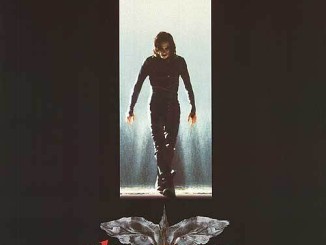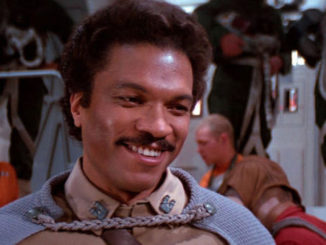In a multi-part series, Comic Book Film Editor William Gatevackes will be tracing the history of comic book movies from the earliest days of the film serials to today’s big blockbusters and beyond. Along with the history lesson, Bill will be covering some of the most prominent comic book films over the years and why they were so special. This time, we come to the dark ages of the Batman franchise—Batman Forever and Batman and Robin.
I can trace the moment I knew the Batman franchise was in trouble to one particular scene in Batman Forever. Batman, now played by Val Kilmer, had just finished a heart to heart with Dr. Chase Meridian (Nicole Kidman) and as he leaves, Meridian tells him to be careful out there. Batman, whose back is to Meridian yet facing the camera, flashes the goofiest grin you would ever see. No, not a subtle smile or a acerbic smirk, but the type of grin the school bookworm in an ABC Family telefilm would grin if she was just asked out by the star quarterback. You can see the grin around the 1:47 mark on the trailer.
I don’t know if this was a particular director’s note from new franchise director Joel Schumacher or a sly bit of sabotage by Kilmer (who’s combative relationship with Schumacher doing filming was legendary), but the smile was so glaringly out of character that it made me fear for the franchise’s future.
Warner Brothers was not happy with Batman Returns’ $266,822,354 box office take, and put the blame for what they felt was a lackluster performance on the dark tone Tim Burton gave to the film. Warners convinced Burton to move to producer and brought in Schumacher with an eye on making a more kid-friendly (and toy generating) flick. Michael Keaton bailed on the franchise once he found out the direction it was going in. Smart man.
 Schumacher replaced Burton’s dark moodiness with a garish, neon soaked cyberpunk look. Batman Forever was a loud assault on the senses. We begin to see more campy elements make their way into the film, including, but not limited to, the Batmobile being driven up a wall, the over-the-top performances of Jim Carrey as the Riddler and Tommy Lee Jones, who stepped in for Billy Dee Williams as Harvey Dent/Two-Face, and a painful, self-referential gag about “holey rusted metal” at the bad guy’s hideout. Schumacher also added nipples to the batsuit and an uncomfortable focus on generous codpieces and vinyl clad buttocks of Batman and Robin during the inevitable “suiting up” montages—a bit too hyper sexualized for what was supposed to be a kid’s film, in my opinion.
Schumacher replaced Burton’s dark moodiness with a garish, neon soaked cyberpunk look. Batman Forever was a loud assault on the senses. We begin to see more campy elements make their way into the film, including, but not limited to, the Batmobile being driven up a wall, the over-the-top performances of Jim Carrey as the Riddler and Tommy Lee Jones, who stepped in for Billy Dee Williams as Harvey Dent/Two-Face, and a painful, self-referential gag about “holey rusted metal” at the bad guy’s hideout. Schumacher also added nipples to the batsuit and an uncomfortable focus on generous codpieces and vinyl clad buttocks of Batman and Robin during the inevitable “suiting up” montages—a bit too hyper sexualized for what was supposed to be a kid’s film, in my opinion.
Batman Forever was a success, making $336,529,844 at the box office. A sequel was put on the fast track, with George Clooney replacing the contentious Kilmer as Bruce Wayne/Batman. And, thusly, Batman & Robin was unleashed onto an unsuspecting world.
Batman & Robin was unabashedly, unapologetically campy. It was also horrible. Those of you, the lucky few who didn’t see the movie, might be asking a few questions. How campy was it? How bad could it really be? Let me show you:
I wonder what he does when he tries to use it at places that require a form of ID to verify the card. Does he toss a batarang on the counter? A typewritten list of all his daddy issues?
 Clooney often speaks in a self-deprecating way about his performance in the film, like he’s solely to blame for how awful it is. He’s not. His portrayal of Bruce Wayne is a bright spot in the film. And his performance as Batman is hampered by the horrible screenwriting of Akiva Goldsman, who unbelievably would later win an Oscar for writing 2002’s A Beautiful Mind.
Clooney often speaks in a self-deprecating way about his performance in the film, like he’s solely to blame for how awful it is. He’s not. His portrayal of Bruce Wayne is a bright spot in the film. And his performance as Batman is hampered by the horrible screenwriting of Akiva Goldsman, who unbelievably would later win an Oscar for writing 2002’s A Beautiful Mind.
What did Goldsman and Schumacher get wrong this time around? Well, are you sitting down? You have to start with lame gags like the Bat-Credit Card. Then the lame puns spouted by all the characters, especially Arnold Schwarzenegger’s Mr. Freeze (it’s like Goldsman took all the “ice” related puns he could think of and put them all, good or bad, into the film).
Then you had Chris O’Donnell, who gave the worst performance by a grown man (he would turn 27 six days after the film opened) pretending to be a teenager overacting his way through an immature, crybaby tantrum (he’d hold the title until Hayden Christensen’s performance in 2002’s Star Wars: Episode II – Attack of the Clones). The film also introduced  Batgirl in the personage of Alicia Silverstone, who played Bruce Wayne’s British butler Alfred’s niece, who came directly from her studies in London to visit her uncle, leaving all traces of any kind of British accent behind. She did have nipples on her batsuit and a lingering shot or two of her curves during her suiting up montage, proving that Schumacher is an equal opportunity fetishist.
Batgirl in the personage of Alicia Silverstone, who played Bruce Wayne’s British butler Alfred’s niece, who came directly from her studies in London to visit her uncle, leaving all traces of any kind of British accent behind. She did have nipples on her batsuit and a lingering shot or two of her curves during her suiting up montage, proving that Schumacher is an equal opportunity fetishist.
There were also too many characters this time around. In addition to those already mentioned, you had Uma Thurman playing Poison Ivy as the second major villain (because you had to have two major villains in a Batman film). Plus, you had Bane, a character who broke Batman’s back in the comic books, a character that Christopher Nolan felt strong enough about to make a main villain in The Dark Knight Rises, relegated to a mindless, brutal lackey of Poison Ivy. An even bigger waste was the character of Jason Woodrue, who was an awesome character in the comics by the name of Floronic Man and was portrayed by the excellent actor John Glover. His only purpose was to establish Poison Ivy’s origin by being the mad scientist who gives her superpowers as a result of trying to kill her. He is killed off after only five minutes of screen time.
The film was critically lambasted and while it earned $238,207,122, it was the lowest grossing Batfilm to date and, therefore, a failure. Positive response to the rushes put a third Schumacher sequel titled Batman Triumphant into pre-production with Clooney and O’Donnell reprising their roles and the Scarecrow as the main villain. The disappointing response cancelled that film and caused Warners to look towards rebooting the franchise. It also garnered an apology from Schumacher himself.
The Scarecrow would become the villain of the next Batman film, one which would come closest to capturing the comic book feel on the big screen. But before that, a legendary comic book arc almost made it to movie theaters. We’ll tell you which one next time.




